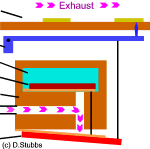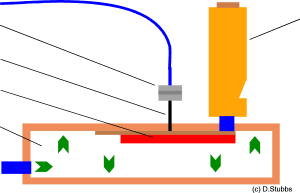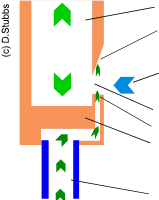

(This page is not included in the PDF version)
More Frequently Asked Questions...

Some organs use a ‘Keyed’ system where small metal fingers, or ‘Keys’ rise through the holes in the music book to play the organ. This requires a much heavier type of cardboard.
Music book
Key
Air from blower
Inside Valve
Touch Box
Outside Valve

Air Motor
‘Sticker’
Pallet
Windchest
Compressed Air
from blower
from blower
Organ Pipe
Tubing to connect keyframe to pallet motor
Simplified animation of Keyed action

A: The air enters through the foot of the pipe and is directed towards the ‘Mouth’ and ‘Upper Lip’ via small jets in the ‘Lower Lip’. With no airflow, the pressure inside the pipe is equal to the outside atmospheric pressure. As the air passes over the mouth, it causes a pressure drop (moving air is at a lower pressure than stationary air), which forces a quantity of air inside the pipe to move towards the mouth. As the inside pressure falls, the outside air, which is at a relatively higher pressure, begins to push the air jets from the lower lip towards the inside of the pipe to equalize the reducing pressure. Eventually, the pressure is re-balanced and the airflow returns to the outside again. The cycle repeats continuously, causing the air column inside the pipe to oscillate.
Once oscillations are established, the pipes natural ‘Resonance’ will determine the frequency produced. The resonant frequency, or ‘Pitch’, to use a musical term, is determined by the volume of air to be moved. A small pipe has less air and will therefore cause the air column to move back and forth faster, giving a higher pitch. Conversely, a larger pipe has more air to move and will take longer to complete each cycle, yielding a lower pitch.
To give an idea of the rate that the air has to move, Middle-C is 261 cycles per second (‘Hertz’). This means that the air has to move in and out of the pipe 261 times every second!
Once oscillations are established, the pipes natural ‘Resonance’ will determine the frequency produced. The resonant frequency, or ‘Pitch’, to use a musical term, is determined by the volume of air to be moved. A small pipe has less air and will therefore cause the air column to move back and forth faster, giving a higher pitch. Conversely, a larger pipe has more air to move and will take longer to complete each cycle, yielding a lower pitch.
To give an idea of the rate that the air has to move, Middle-
Organ Pipe Airflow Animation
Air column inside pipe body
Upper Lip
Atmospheric air pressure
Pipe Mouth
Lower Lip
The ‘Languid’
Pipe Foot
Q: How does an organ pipe work?